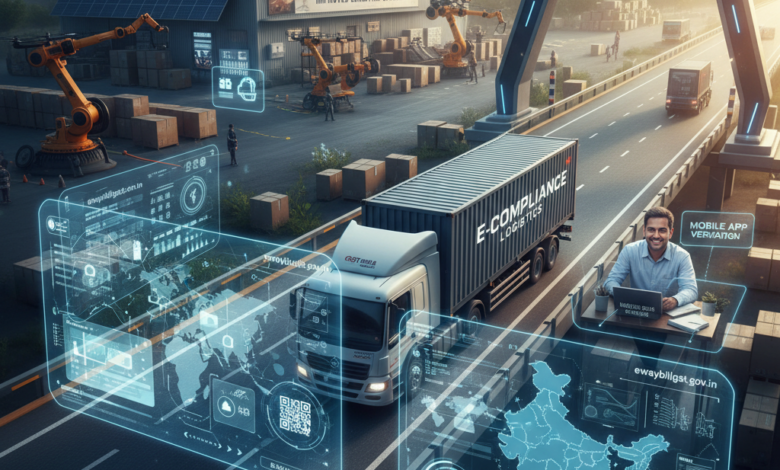GST E-Way Bill System – Benefits and Challenges in 2025

Introduction
The Goods and Services Tax (GST) E-Way Bill system is one of the most significant innovations in India’s tax administration. Introduced to track the movement of goods and ensure transparency, it has transformed logistics and compliance for businesses.
In 2025, the E-Way Bill system continues to be vital for GST compliance. With technology-driven improvements and stricter enforcement, it affects nearly every business engaged in the movement of goods.
This blog will explore the *benefits, challenges, and process of the GST E-Way Bill system*, helping businesses understand its importance and manage compliance efficiently.
What is the GST E-Way Bill System?
The E-Way Bill is an electronic document generated on the GST portal that is required for transporting goods worth more than ₹50,000 within or across states. It contains details of the goods, consignor, consignee, and transporter.
It acts as a compliance mechanism to ensure that goods moving in the supply chain are reported accurately and GST payments are made.
Benefits of the GST E-Way Bill System
1. Transparency in Goods Movement*
The E-Way Bill ensures that goods are transported legally and their movement is traceable. This reduces tax evasion and improves compliance.
2. Ease of Interstate Trade*
A unified E-Way Bill system removes the need for separate state-level documentation, reducing delays and paperwork for businesses.
3. Reduction in Tax Evasion*
By linking E-Way Bills with GST returns, authorities can detect unreported transactions and prevent tax leakage.
4. Improved Logistics Efficiency*
Real-time tracking of goods movement enables better planning and management in supply chains.
5.Digital Compliance*
E-Way Bill generation is fully digital, reducing manual errors and making compliance more efficient.
GST E-Way Bill Process in 2025
Step 1: Determine Requirement
An E-Way Bill is mandatory if:
Goods movement value exceeds ₹50,000.
Goods are transported interstate or intrastate for business purposes.
Step 2: Generate E-Way Bill
Log into the E-Way Bill Portal (ewaybillgst.gov.in) or use a GST-enabled accounting system.
Enter details: GSTIN, invoice number, transport details, goods description, HSN code, and value.
Step 3: Generate E-Way Bill Number (EBN)
Once submitted, an E-Way Bill Number is generated. This must be carried along with the goods during transportation.
Step 4: Verification During Transit
Tax authorities may check E-Way Bills via physical inspection or mobile verification systems.
Step 5: Record Keeping
Businesses must keep E-Way Bill details for at least six months for audit and compliance purposes.
Challenges of the GST E-Way Bill System
1. Technical Issues*
Businesses sometimes face delays due to portal downtime or slow processing.
2. Complexity for Small Businesses*
Small businesses transporting goods frequently may find it difficult to manage E-Way Bill generation without automation tools.
3. Penalty Risks*
Failure to generate an E-Way Bill or errors in details can attract penalties.
4. Training and Awareness*
Many small and medium-sized businesses lack awareness of E-Way Bill rules, leading to non-compliance.
5. Integration with Logistics*
Ensuring that transport partners and vendors comply with E-Way Bill rules can be challenging.
GST E-Way Bill Reforms in 2025
The government has introduced several changes to improve the E-Way Bill system:
1. Integration with GST Portal* – Automatic pre-filling of invoice details.
2. Mobile App for E-Way Bill Generation* – Ease of generating bills on the go.
3. Extended Validity Rules* – Based on distance travelled and type of goods.
4. Reduced Compliance Burden* – For low-value goods under certain thresholds.
5. Real-time Tracking* – AI-based monitoring for better enforcement.
Case Studies: E-Way Bill in Practice
Example 1 – Manufacturing Company
A Delhi-based manufacturer transporting goods across India has streamlined operations by integrating E-Way Bill generation with their ERP system. This reduced delays and improved compliance.
Example 2 – Small Retailer
A retailer transporting goods between branches faced challenges with manual E-Way Bill generation. Switching to an automated GST-enabled software reduced errors and saved time.
Example 3 – Logistics Provider
A logistics provider uses real-time E-Way Bill tracking to improve delivery accuracy and compliance for clients.
Expert Opinions
Tax Consultants* say the E-Way Bill system has improved compliance but needs more automation to reduce complexity.
Small Business Owners* stress the need for awareness programs to avoid penalties.
Logistics Experts* appreciate real-time tracking but call for simpler generation processes.
Best Practices for Businesses to Manage E-Way Bill Compliance
Automate E-Way Bill Generation* – Integrate with accounting or ERP systems.
Maintain Accurate Documentation* – Ensure invoices match transport details.
Train Staff* – Ensure personnel understand rules and deadlines.
Stay Updated* – Follow changes in E-Way Bill rules and validity periods.
Use the Mobile App* – For on-the-go bill generation and tracking.
Conclusion
The GST E-Way Bill system is a powerful tool for improving transparency, reducing tax evasion, and streamlining goods movement in India. In 2025, technological enhancements and policy reforms are making the system more efficient.
For businesses, compliance with E-Way Bill rules is not just a legal obligation — it’s a strategic move that improves logistics efficiency, reduces delays, and builds trust with partners and customers.
By understanding the process, investing in automation, and staying updated with changes, businesses can turn the E-Way Bill system into a competitive advantage rather than a compliance burden.
FAQs – GST E-Way Bill
*Q1. When is an E-Way Bill required?*
When goods worth more than ₹50,000 are transported for business purposes.
*Q2. How is an E-Way Bill generated?*
Through the GST E-Way Bill portal or GST-enabled accounting software.
*Q3. What are the penalties for not generating an E-Way Bill?*
Penalties up to ₹10,000 or the tax amount, whichever is higher, plus confiscation of goods.
*Q4. How long should E-Way Bill details be stored?*
At least six months for compliance and audits.
*Q5. Has the E-Way Bill system improved compliance?*
Yes, it has enhanced transparency and reduced tax evasion, though challenges remain.



